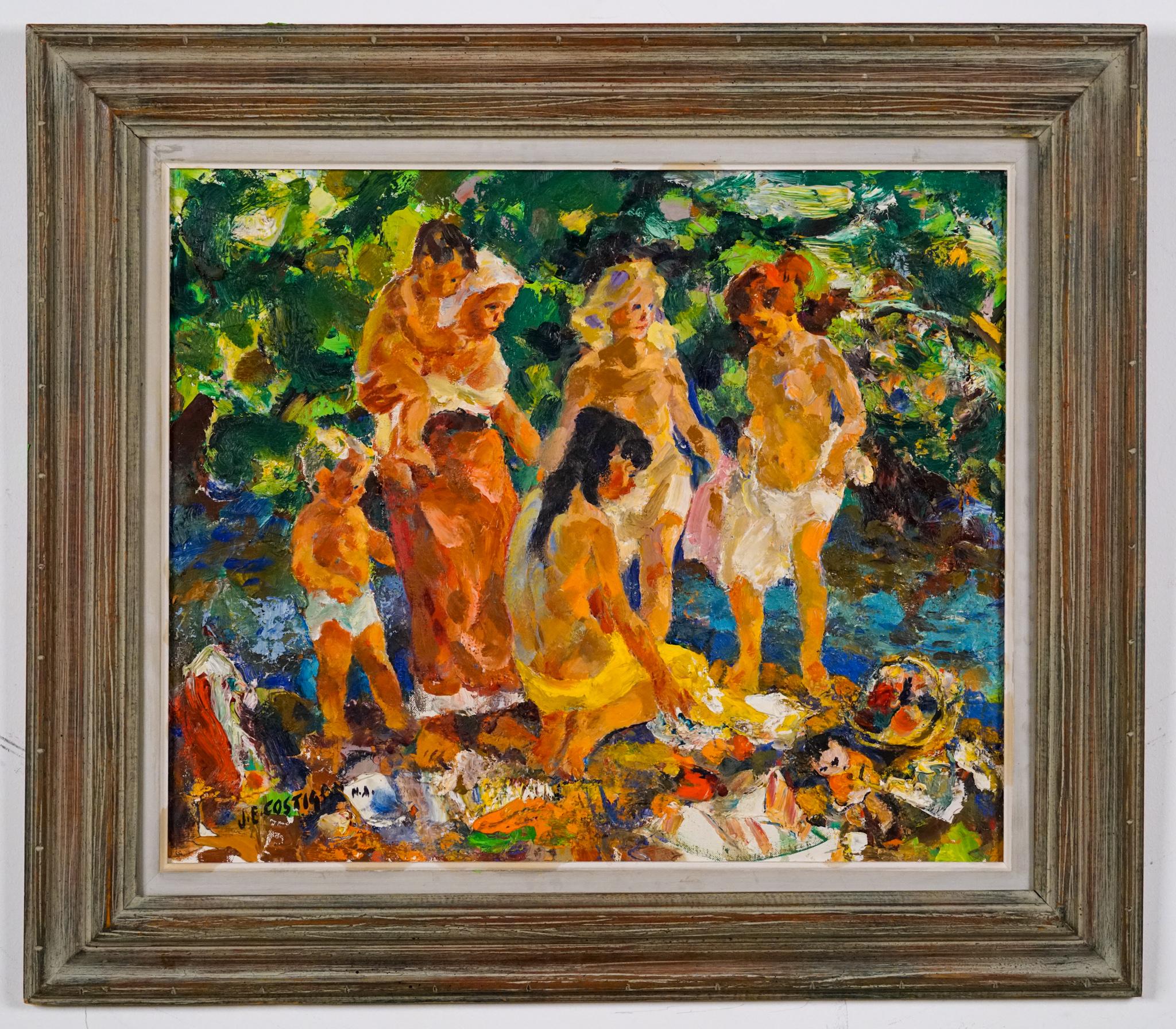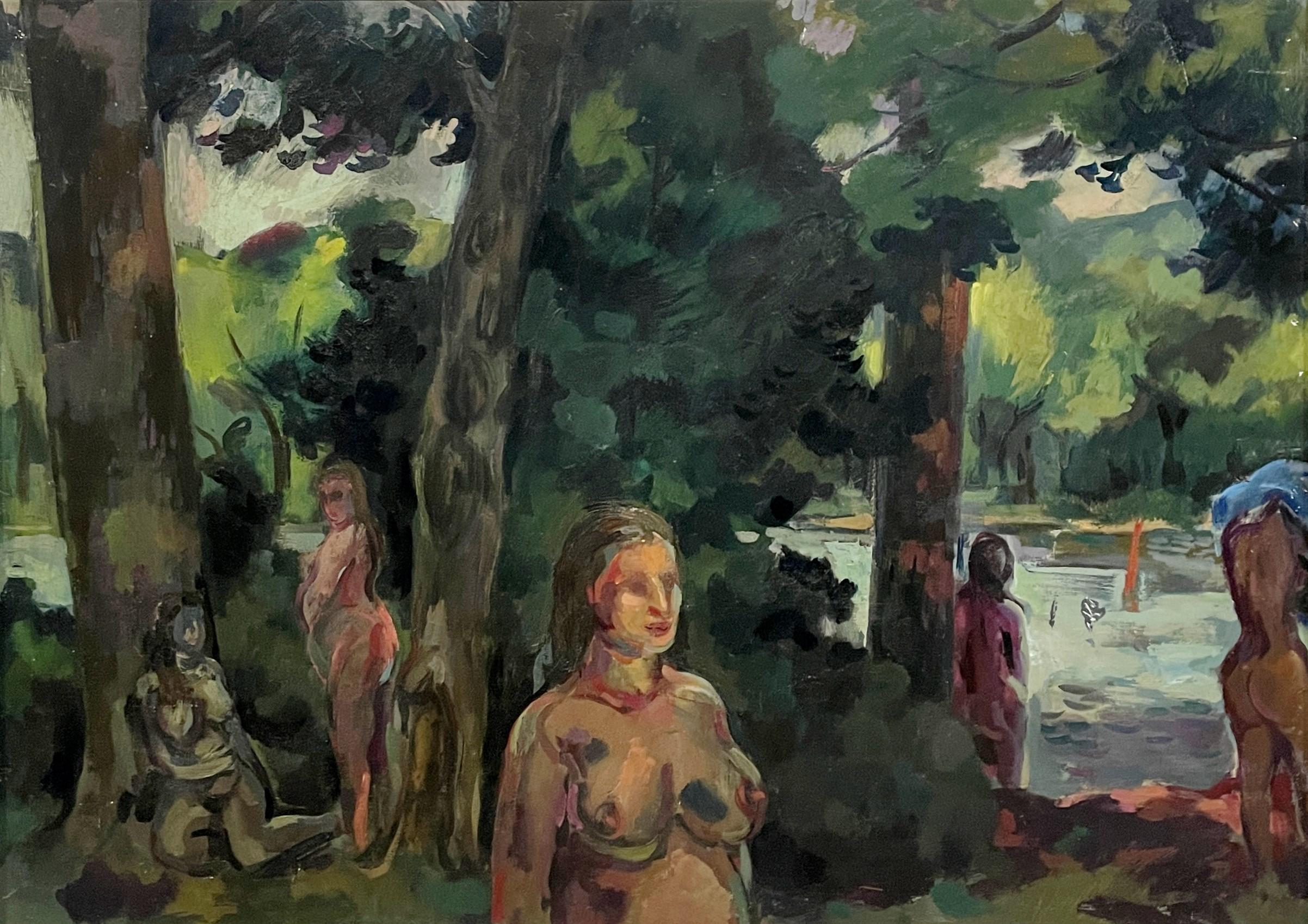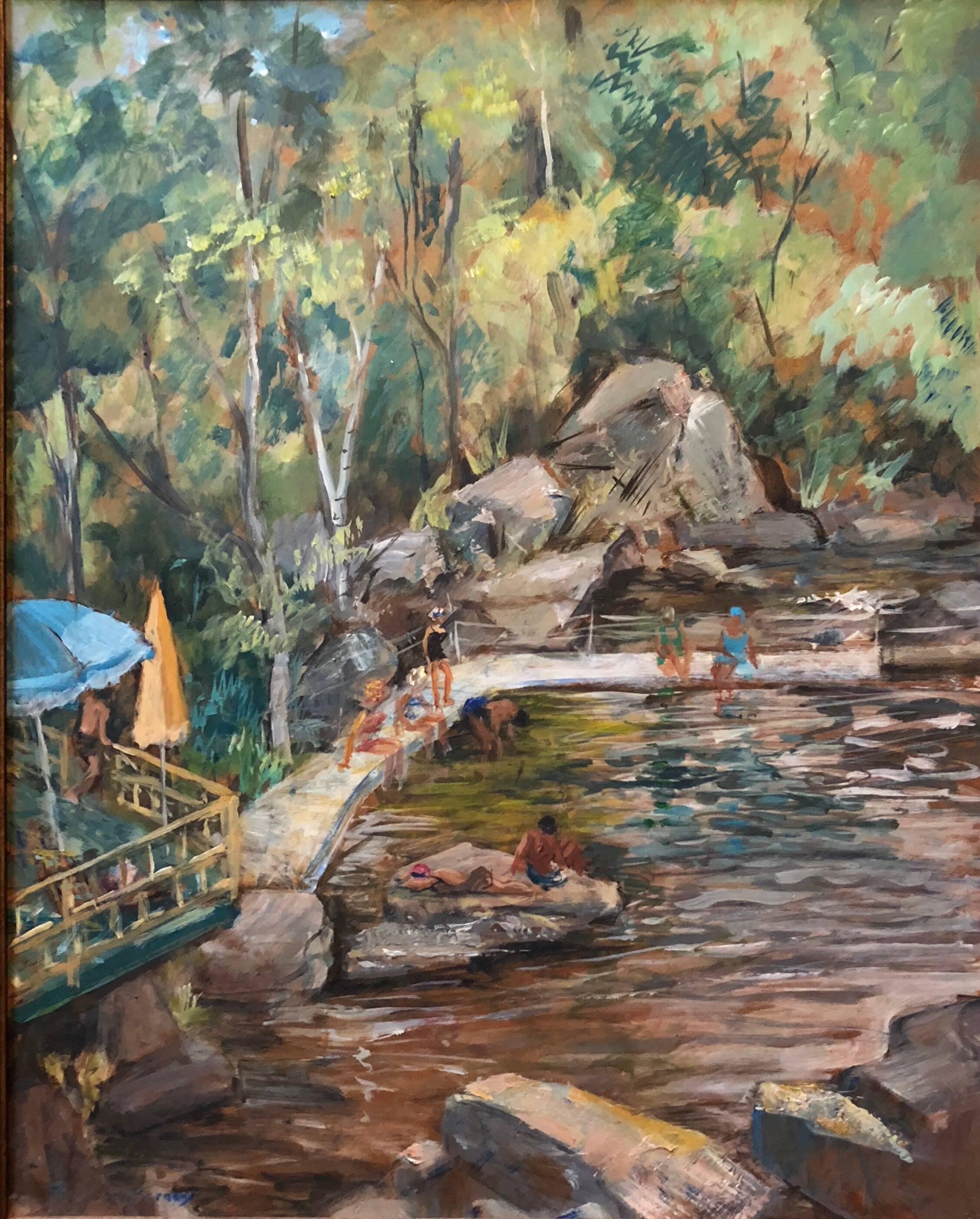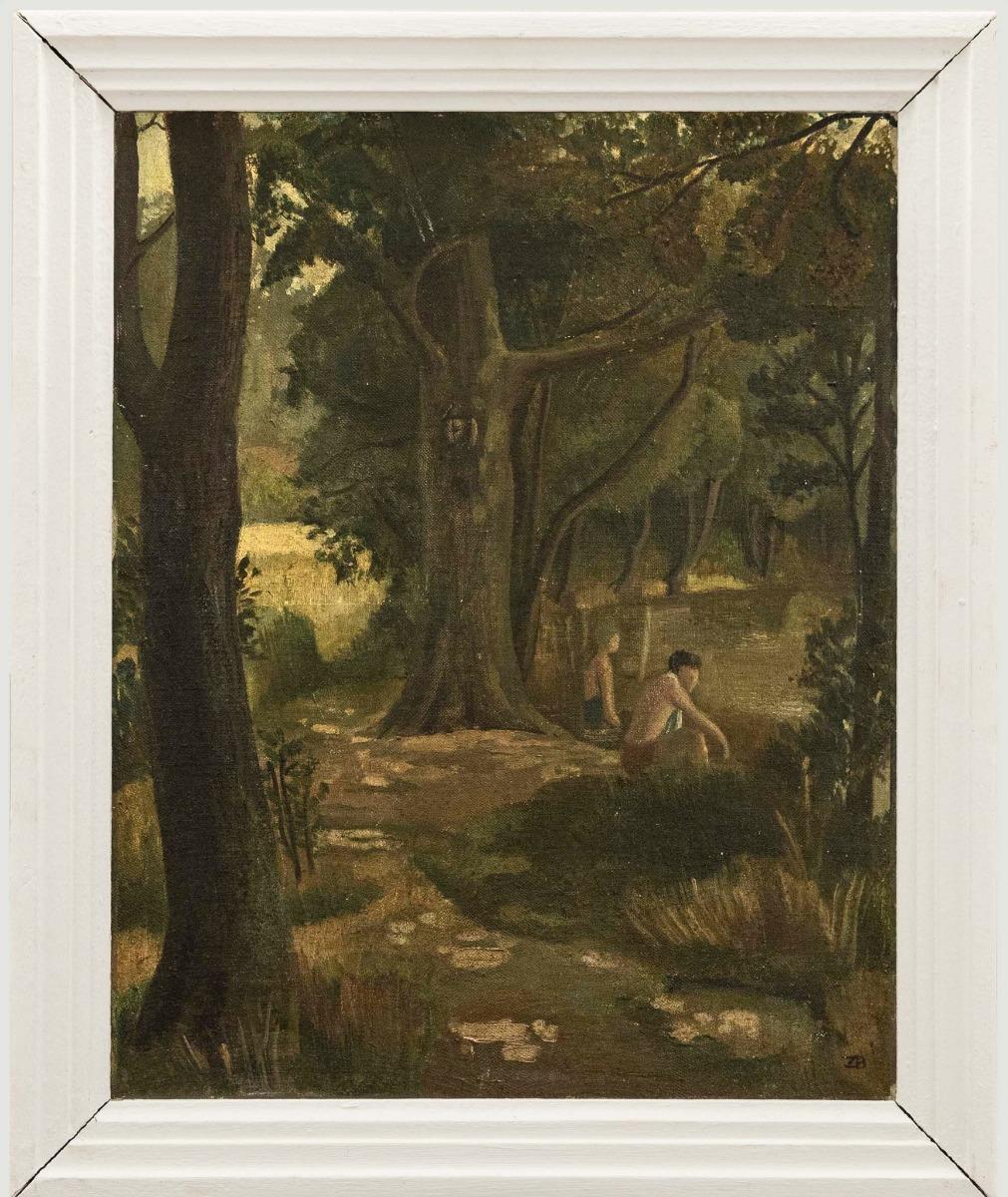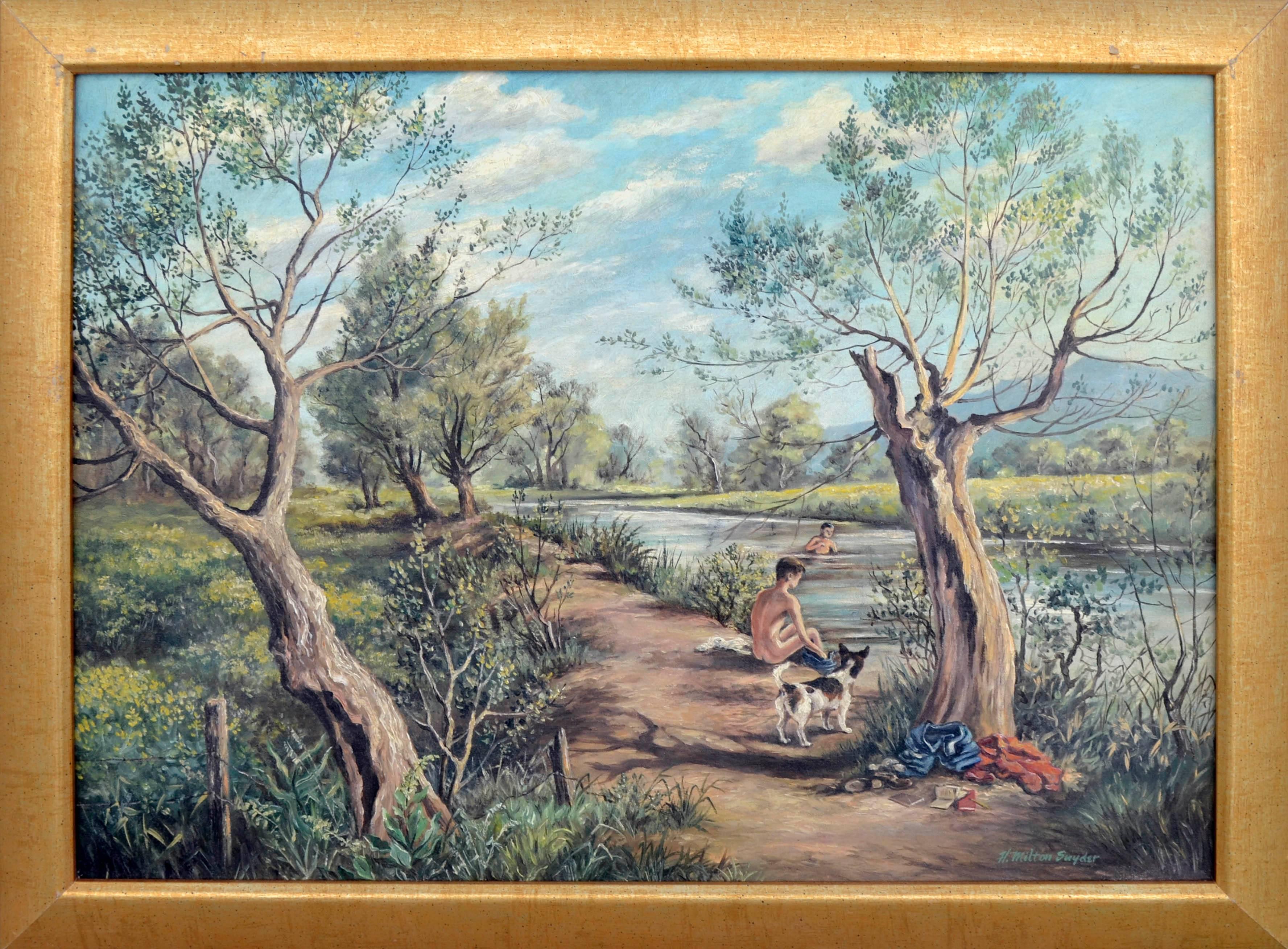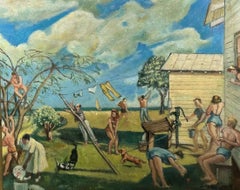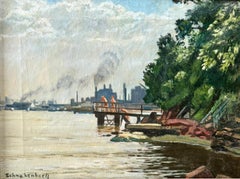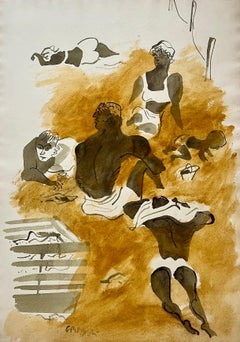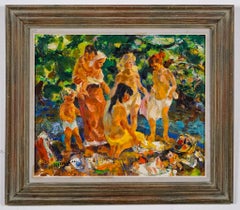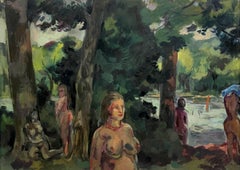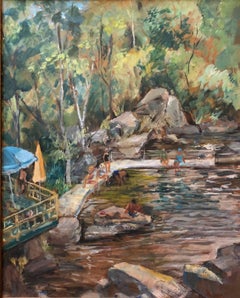Items Similar to Bathers 1940s Mid 20th Century American Scene Social Realism WPA Modern Ashcan
Want more images or videos?
Request additional images or videos from the seller
1 of 7
Marion GilmoreBathers 1940s Mid 20th Century American Scene Social Realism WPA Modern Ashcan1940s
1940s
$3,900
£2,947.10
€3,403.18
CA$5,449.66
A$6,046.86
CHF 3,167.47
MX$74,150.72
NOK 40,289.18
SEK 38,031.27
DKK 25,379.64
Shipping
Retrieving quote...The 1stDibs Promise:
Authenticity Guarantee,
Money-Back Guarantee,
24-Hour Cancellation
About the Item
Bathers 1940s Mid 20th Century American Scene Social Realism WPA Modern Ashcan
Marion Gilmore (1909-1984)
Bathers
15 1/2 x 19 1/2 inches
oil on canvas board
signed lower left
BIO
orn in Ottumwa, Iowa in 1909, Marion Gilmore studied at the School of Fine Arts and Crafts (the Child-Walker School) in Boston, and then at the Art Students League in New York. She later turned to the study of commercial art at the Phoenix Art Institute, working under Norman Rockwell, Franklin Booth, and Thomas Fogarty. After moving to Chicago, she attended the Art Institute and the American Academy.
This WPA artist illustrates the recognition dilemna that has plagued women for years. She returned to her home town and established herself as a noted painter, illustrator, cartoonist, and teacher with two WPA murals in Iowa to her credit. She won prizes in the 48 States Competition held in Corning, Iowa and was exhibited widely. Her art was included in many local collections and institutions.
At some point she married, moved to New York City, and her artistic record stops … under that name of Marion Gilmore. After WWII, continuing to paint using her married name Marion Hulse, she re-established herself as a painter, sculptor, designer and illustrator. At some point, probably because of the subtle prejudice against women artists, she signed some of her paintings with the "gender neutral" name of Mion (Hulse).
Her work, paintings of ordinary people in Iowa and New York, represent Social Realism and the work of the Ashcan School at its most direct and best. There is a gentle humor in much of her work. Yard Sale and Children in Washington Park were included in an exhibit in January 1995 at the Seiderman Gallery, Lynbrook, NY entitled: "Women Artists". She is discussed in "Democratic Vistas, Public Art in New Deal, and Who Was Who in American Art".
The photo Caption for one of her works from the files of the US Post Office: In Band Concert, by Marion Gilmore, the mural artist portrayed an idealized view of small town America. Gilmore, one of only a few female mural artists who worked for the Section, shows the residents of Corning, Iowa gathered about to listen to an evening band concert in their town square. The original design, which won the commission, drew inspiration from typical Iowa town squares.
It was not, however, an accurate depiction of the square in Corning where the mural was to be installed. Her study added an obelisk and a cannon where none existed in Corning. The Section encouraged Gilmore to change her design to more accurately reflect the Corning town square. Her finished mural eliminated the offending additions. The Study for Band Concert indicates the mural's eventual placement. Most small town post office murals were constructed around the postmaster's door. And, this is where Gilmore's finished mural was eventually hung."
Installed in March 1941, the mural was a stunning success, receiving kudos from citizens as welI as the town newspaper. Corning resident T. B. Turner sent a glowing report to Rowan: "the prominence given indicates not only the high esteem in which our people hold our splendid post office building, but also their appreciation of its crowning glory -- this mural which so artistically and yet so truthfully depicts the happy community 'way of life' in the finest little town in the most liveable section of the most prosperous state of the most democratic country in the whole topsy-turvy world in this problematical year of 1941. I think it helps to boost our confidence in the constructive nature and eventual success of our government programs."
- Creator:Marion Gilmore (1909 - 1984, American)
- Creation Year:1940s
- Dimensions:Height: 25 in (63.5 cm)Width: 29 in (73.66 cm)
- Medium:
- Movement & Style:
- Period:
- Condition:
- Gallery Location:New York, NY
- Reference Number:1stDibs: LU1156211697922
About the Seller
5.0
Gold Seller
Premium sellers maintaining a 4.3+ rating and 24-hour response times
Established in 2008
1stDibs seller since 2019
192 sales on 1stDibs
Typical response time: <1 hour
- ShippingRetrieving quote...Shipping from: New York, NY
- Return Policy
Authenticity Guarantee
In the unlikely event there’s an issue with an item’s authenticity, contact us within 1 year for a full refund. DetailsMoney-Back Guarantee
If your item is not as described, is damaged in transit, or does not arrive, contact us within 7 days for a full refund. Details24-Hour Cancellation
You have a 24-hour grace period in which to reconsider your purchase, with no questions asked.Vetted Professional Sellers
Our world-class sellers must adhere to strict standards for service and quality, maintaining the integrity of our listings.Price-Match Guarantee
If you find that a seller listed the same item for a lower price elsewhere, we’ll match it.Trusted Global Delivery
Our best-in-class carrier network provides specialized shipping options worldwide, including custom delivery.More From This Seller
View AllA Summer Day WPA American Scene Social Realism Modern Ashcan Early 20th Century
By Leon Kroll
Located in New York, NY
A Summer Day WPA American Scene Social Realism Modern Ashcan Early 20th Century
Leon Kroll (1884-1974)
"A Summer Day"
14 x 17 inches (image...
Category
1930s Figurative Paintings
Materials
Oil, Board
"Study for Long Beach" WPA American Scene Social Realism Modernism Ashcan
Located in New York, NY
"Study for Long Beach" WPA Mid 20th Century American Scene Social Realism Modernism Ashcan
Daniel Ralph Celantano (1902-1980)
"Study for Long Beach"
8 x 10 inches
Oil on artist bo...
Category
1930s American Realist Figurative Paintings
Materials
Oil, Board
Boys Swimming Industrial Landscape WPA Mid 20th Century Social Realism Modernism
By Henry Ernst Schnakenberg
Located in New York, NY
Boys Swimming Industrial Landscape WPA Mid 20th Century Social Realism Modernism
Henry Schnakenberg (1982 - 1970)
Boys Swimming Industrial Landscape
11 1/2 x 15 1/2 sight
Oil on Canvas
Signed lower left
14 1/2 x 18 1/2 inches, Framed
Bio
In many cases, American artists visited the Armory Show in New York in 1913, and returned to their studios to react to or against what they saw. However, for Henry Ernest Schnakenberg it was much more life altering. Prior to visiting this important exhibition of American and European modernist art...
Category
1940s American Modern Figurative Paintings
Materials
Canvas, Oil
Family at the Beach WPA Modernism American Scene Social Realism Mid 20th Century
By William Gropper
Located in New York, NY
Family at the Beach WPA Modernism American Scene Social Realism Mid 20th Century
William Gropper (1898 - 1977)
"Family at the Beach"
27 1/2 x 19 1/2 inches
Mixed media on paper, c. 1940
Signed lower left
Provenance: Estate of the artist.
The drawing will ship from the home of Mr. Gropper's grandson.
Bio
Throughout his life, William Gropper used his artistic talents to protest social injustice. Born in New York City, he grew up there in poverty and left high school to work as a dishwasher and delivery boy. He eventually began a career in art and was able to study with Robert Henri and George Bellows from 1912 to 1915. He adopted their realistic painting style, and his own work expressed sympathy for common laborers and outrage at society's ills.
In 1919 Gropper established a reputation as a political cartoonist working for the New York Tribune. His blunt, forceful style attracted the attention of other publications, and he provided illustrations and cartoons for a variety of magazines, from the left-wing New Masses to mainstream Vanity Fair. Like many social realist artists of the 1930s, Gropper supported liberal political causes, depicting subjects such as the plight of migrant laborers and striking factory workers.
In his first gallery exhibition in 1936 at ACA Galleries, Gropper's work was so well received by critics, collectors, and artists that the following year he had two one-man exhibitions at ACA Galleries. In 1937, Gropper traveled west on a Guggenheim Fellowship and visited the Dust Bowl and the Hoover and Grand Coulee Dams, sketching studies for a series of paintings and a mural he painted for the Department of the Interior. That same year he had paintings purchased by both the Metropolitan Museum of Art and the Museum of Modern Art.
Gropper exhibited at the 1939 New York World's Fair, Whitney Museum of American Art (1924-55), Art Institute of Chicago (1935-49), Carnegie International (1937-50), Pennsylvania Academy of the Fine Arts (1939-48), and National Academy of Design (1945-48). He was a founder of the Artists Equity Association and member of the National Institute of Arts and Letters.
From 1940 to 1945 William Gropper was preoccupied with anti-Nazi cartoons...
Category
1940s American Modern Figurative Drawings and Watercolors
Materials
Paper, Ink, Watercolor, Gouache
American Scene Social Realism Mid-20th Century WPA Era Woman Artist Children
Located in New York, NY
American Scene Social Realism Mid-20th Century WPA Era Woman Artist Children
Winnie Borne Sherman (1902-2004)
“Ring around the Rosie”
Pencil on Paperboard, c. 1930s
13 3/8 H x 15 5...
Category
1930s American Realist Figurative Drawings and Watercolors
Materials
Graphite, Board
"Good Health Week" American Scene Modern Social Realism Mid 20th Century WPA Era
By Jo Cain
Located in New York, NY
"Good Health Week" American Scene Modern Social Realism Mid- 20th Century WPA Era
Jo Cain (1904 – 2003)
Good Health Week – b/w
10 ½ x 15 1/2 inches
I...
Category
1930s American Realist Figurative Drawings and Watercolors
Materials
Paper, Ink
You May Also Like
Fernande Horovitz-Edwards, Bathers, Large Oil on Canvas, 1930s
Located in Saint Amans des cots, FR
Large Oil on Canvas by Fernande Horovitz-Edwards, France, 1930s - "Bathers". This large oil on canvas by Fernande Horovitz-Edwards, titled Bathers, dates from the 1930s and showcases...
Category
1930s Post-Impressionist Figurative Paintings
Materials
Canvas, Oil
Bathers
By John Edward Costigan
Located in Sheffield, MA
John Edward Costigan, N.A.
American, 1888-1972
Bathers
Oil on canvas
Signed ‘J.E. Costigan N.A.’ lower left
20 by 24 in. W/frame 26 by 30 in.
John Costigan was born of Irish-American parents in Providence, Rhode Island, February 29, 1888. He was a cousin of the noted American showman, George M. Cohan, whose parents brought the young Costigan to New York City and was instrumental in starting him on a career in the visual arts. They were less successful in encouraging him to pursue formal studies at the Art Students League (where, however, he later taught) than in exposing him to the commercial art world through the job they had gotten him with the New York lithographing firm that made their theatrical posters.
At the H. C. Miner Lithographing Company, Costigan worked his way up from his entry job as a pressroom helper, through various apprenticeships, to the position of sketch artist. In the latter capacity he was an uncredited designer of posters for the Ziegfeld Follies and for numerous silent films. Meanwhile, he had supplemented his very meager formal studies in the fine arts with a self-teaching discipline that led to his first professional recognition in 1920 with the receipt of prizes for an oil painting and watercolor in separate New York exhibitions.
A year earlier, Costigan had wed professional model Ida Blessin, with whom he established residence and began raising a family in the sleepy little rural New York hamlet of Orangeburg, the setting for the many idyllic farm landscapes and wood interiors with which he was to become identified in a career that would span half a century.
John Costigan’s first national recognition came in 1922 with his winning of the coveted Peterson Purchase prize of the Art Institute of Chicago for an oil on canvas, “Sheep at the Brook.” It marked the start of an unbroken winning streak that would gain him at least one important prize per year for the remainder of the decade. The nation’s art journalists and critics began to take notice, making him the recurring subject of newspaper features and magazine articles. The eminent author and critic Edgar Holger Cahill was just a fledgling reporter when he wrote his first feature, “John Costigan Carries the Flame,” for Shadowland Magazine in 1922. Costigan had his first one-man show of paintings at the Rehn Gallery on New York’s 5th Avenue in November, 1924, to be followed less than three years later by another at the Art Institute of Chicago. In addition, Costigan’s work has been—and continues to be included, side-by-side with that of some of America’s most high-profile artists, in museum and gallery exhibitions throughout the country. His renown had peaked in the early 1930s, by which time his work had been honored with nearly every major award then being bestowed in the fine arts and had been acquired for the permanent collections of several prestigious American museums, including New York’s Metropolitan (which only recently, in 1997, deaccessioned his “Wood Interior,” acquired in 1934).
Although Costigan’s celebrity had ebbed by the late 1930s, the Smithsonian Institution saw fit in 1937 to host an exhibition exclusively of his etchings. And, in 1941, the Corcoran Gallery (also Washington, D.C.) similarly honored him for his watercolors. (Another Washington institution, the Library of Congress, today includes 22 Costigan etchings and lithographs in its permanent print collection.)
During World War II, Costigan returned briefly to illustrating, mainly for Bluebook, a men’s pulp adventure magazine. A gradual revival of interest in his more serious work began at the end of the war, culminating in 1968 with the mounting of a 50-year Costigan retrospective at the Paine Art Center and Arboretum in Oshkosh, Wisconsin. Oils, watercolors and prints were borrowed from museums and private collections throughout the country, and the exhibition was subsequently toured nationally by the Smithsonian Institution.
John Costigan died of pneumonia in Nyack, NY, August 5, 1972, just months after receiving his final prestigious award —the Benjamin West Clinedinst Medal of the Artist’s Fellowship, Inc., presented in general recognition of his “...achievement of exceptional artistic merit...” in the various media he had mastered in the course of his career.
This painting depicts one of the artist's favorite themes --the farm family bathing...
Category
1950s Post-Impressionist Figurative Paintings
Materials
Oil
A Dynamic Mid-Century Modern Summer Landscape Painting w. Bathers by Rudolph Pen
Located in Chicago, IL
A large, dynamic Mid-Century summer landscape painting with female bathers by noted Chicago artist, Rudolph Pen. A wonderful example of the artist's uniquely expressive figurative w...
Category
Mid-20th Century American Modern Landscape Paintings
Materials
Masonite, Oil
Bathers at the Quarry 1940s American Modernist Oil Painting WPA era
By Theresa Berney Loew
Located in Surfside, FL
Swimmers and sun tanners at the local watering hole.
Her birth name was Theresa Berney. At the time of her passing she was known as Theresa Loew.
Birth place: Baltimore
artist, blo...
Category
1940s American Modern Landscape Paintings
Materials
Oil, Board
Zelma Blakely (1921-1979) - Mid 20th Century Oil, Summer Swimming
Located in Corsham, GB
This charming scene shows two figures sat on the edge of a woodland lake after swimming. The artist captures the figures under the shade of large trees which cast shadows over the sc...
Category
20th Century Landscape Paintings
Materials
Oil
$661 Sale Price
20% Off
Afternoon Swim, Mid Century Figurative Landscape
By H. Milton Snyder
Located in Soquel, CA
Afternoon swim, a lovely mid century figurative landscape, by California artist, Henry Milton Snyder (American, 1915-1966). Presented in a giltwood frame. Signed "H. Milton Snyder" l...
Category
1940s American Impressionist Landscape Paintings
Materials
Canvas, Oil
$1,180 Sale Price
20% Off
More Ways To Browse
1940s Modern Art
19 Century Oil Paintings American
Wpa Mural
Ashcan New York
American Ashcan
Oil On Board Paintings 1940s
Ashcan Oil Painting
Mid Century Turner
Wpa Mural Study
Washington Square Park
Booth Painter
Corn Oil
Corn Oil Painting
Small Cannon
Wpa Paintings Social Realism
Booth Mid Century
Mid Century Door Stop
Norman Walker
